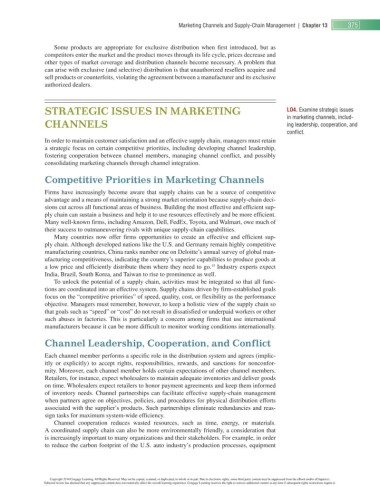Page 408 - Foundations of Marketing
P. 408
Marketing Channels and Supply-Chain Management | Chapter 13 375
Some products are appropriate for exclusive distribution when first introduced, but as
competitors enter the market and the product moves through its life cycle, prices decrease and
other types of market coverage and distribution channels become necessary. A problem that
can arise with exclusive (and selective) distribution is that unauthorized resellers acquire and
sell products or counterfeits, violating the agreement between a manufacturer and its exclusive
authorized dealers.
STRATEGIC ISSUES IN MARKETING LO 4 . Examine strategic issues
in marketing channels, includ-
CHANNELS ing leadership, cooperation, and
conflict.
In order to maintain customer satisfaction and an effective supply chain, managers must retain
a strategic focus on certain competitive priorities, including developing channel leadership,
fostering cooperation between channel members, managing channel conflict, and possibly
consolidating marketing channels through channel integration.
Competitive Priorities in Marketing Channels
Firms have increasingly become aware that supply chains can be a source of competitive
advantage and a means of maintaining a strong market orientation because supply-chain deci-
sions cut across all functional areas of business. Building the most effective and efficient sup-
ply chain can sustain a business and help it to use resources effectively and be more efficient.
Many well-known firms, including Amazon, Dell, FedEx, Toyota, and Walmart, owe much of
their success to outmaneuvering rivals with unique supply-chain capabilities.
Many countries now offer firms opportunities to create an effective and efficient sup-
ply chain. Although developed nations like the U.S. and Germany remain highly competitive
manufacturing countries, China ranks number one on Deloitte’s annual survey of global man-
ufacturing competitiveness, indicating the country’s superior capabilities to produce goods at
15
a low price and efficiently distribute them where they need to go. Industry experts expect
India, Brazil, South Korea, and Taiwan to rise to prominence as well.
To unlock the potential of a supply chain, activities must be integrated so that all func-
tions are coordinated into an effective system. Supply chains driven by firm-established goals
focus on the “competitive priorities” of speed, quality, cost, or flexibility as the performance
objective. Managers must remember, however, to keep a holistic view of the supply chain so
that goals such as “speed” or “cost” do not result in dissatisfied or underpaid workers or other
such abuses in factories. This is particularly a concern among firms that use international
manufacturers because it can be more difficult to monitor working conditions internationally.
Channel Leadership, Cooperation, and Conflict
Each channel member performs a specific role in the distribution system and agrees (implic-
itly or explicitly) to accept rights, responsibilities, rewards, and sanctions for nonconfor-
mity. Moreover, each channel member holds certain expectations of other channel members.
Retailers, for instance, expect wholesalers to maintain adequate inventories and deliver goods
on time. Wholesalers expect retailers to honor payment agreements and keep them informed
of inventory needs. Channel partnerships can facilitate effective supply-chain management
when partners agree on objectives, policies, and procedures for physical distribution efforts
associated with the supplier’s products. Such partnerships eliminate redundancies and reas-
sign tasks for maximum system-wide efficiency.
Channel cooperation reduces wasted resources, such as time, energy, or materials.
A coordinated supply chain can also be more environmentally friendly, a consideration that
is increasingly important to many organizations and their stakeholders. For example, in order
to reduce the carbon footprint of the U.S. auto industry’s production processes, equipment
Copyright 2014 Cengage Learning. All Rights Reserved. May not be copied, scanned, or duplicated, in whole or in part. Due to electronic rights, some third party content may be suppressed from the eBook and/or eChapter(s).
Editorial review has deemed that any suppressed content does not materially affect the overall learning experience. Cengage Learning reserves the right to remove additional content at any time if subsequent rights restrictions require it.

